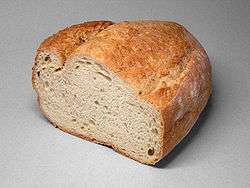History of bread
Bread was central to the formation of early human societies. From the Fertile Crescent, where wheat was domesticated, cultivation spread north and west, to Europe and North Africa, and east towards East Asia. This in turn led to the formation of towns, as opposed to the nomadic lifestyle, and gave rise to more and more sophisticated forms of societal organization. Similar developments occurred in the Americas with maize and in Asia with rice.
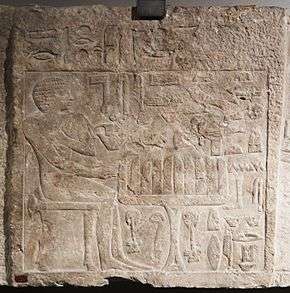
Antiquity
Charred crumbs of a flatbread made by Natufian hunter-gatherers from wild wheat, wild barley and plant roots between 14,600 and 11,600 years ago have been found at the archaeological site of Shubayqa 1 in the Black Desert in Jordan, predating the earliest known making of bread from cultivated wheat by thousands of years.[1][2] Grinding stones dated at 30,000 years old, possibly used for grinding grains and seeds into flour, have in recent years been unearthed in Australia and Europe, but there is no definitive evidence that these tools or their products were used for making breads.[3][4]
Bread is otherwise strongly associated with agriculture. Wheat was domesticated in the Fertile Crescent.[5][6] Bread is found in Neolithic sites in Turkey and Europe from around 9,100 years ago.[2][7][8]
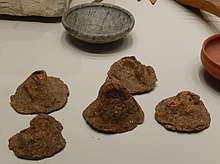
There is extensive evidence of breadmaking in Ancient Egypt in the form of artistic depictions, remains of structures and items used in bread making, and remains of the dough and bread itself.[9][10][11][12][13][14]
The most common source of leavening in antiquity was to retain a piece of dough (with sugar and water in) from the previous day to utilize as a form of sourdough starter.[15] Pliny the Elder reported that the Gauls and Iberians used the foam skimmed from beer to produce "a lighter kind of bread than other peoples." Parts of the ancient world that drank wine instead of beer used a paste composed of grape must and flour that was allowed to begin fermenting, or wheat bran steeped in wine, as a source for yeast.
The idea of a free-standing oven that could be pre-heated, with a door for access, appears to have been Greek.[16]
Even in antiquity there was a wide variety of breads. In ancient times the Greek bread was barley bread: Solon declared that wheaten bread might only be baked for feast days. By the 5th century BC bread could be purchased in Athens from a baker's shop, and in Rome, Greek bakers appeared in the 2nd century BC, as Hellenized Asia Minor was added to Roman dominion as the province of Asia;[17] the foreign bakers of bread were permitted to form a collegium. In the Deipnosophistae, the author Athenaeus (c.A.D.170 – c. 230) describes some of the bread, cakes, and pastries available in the Classical world.[18] Among the breads mentioned are griddle cakes, honey-and-oil bread, mushroom-shaped loaves covered in poppy seeds, and the military specialty of rolls baked on a spit. The type and quality of flours used to produce bread could also vary, as noted by Diphilus when he declared "bread made of wheat, as compared with that made of barley, is more nourishing, more digestible, and in every way superior." In order of merit, the bread made from refined [thoroughly sieved] flour comes first, after that bread from ordinary wheat, and then the unbolted, made of flour that has not been sifted."[19] The essentiality of bread in the diet was reflected in the name for the rest of the meal: ópson, "condiment", i.e. bread's accompaniment, whatever it might be.[20]
Middle Ages
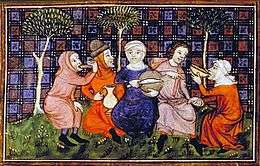
In medieval Europe, bread served not only as a staple food but also as part of the table service. In the standard table setting of the day the trencher, a piece of stale bread roughly 6 inches by 4 inches (15 cm by 10 cm), was served as an absorbent plate. At the completion of a meal the trencher could then be eaten, given to the poor, or fed to the dogs. It was not until the 15th century that trenchers made of wood started to replace the bread variety.[21]
To the 19th century
Up to the 19th century, bread sold in Europe was often adulterated with hazardous materials, including chalk, sawdust, alum, plaster, clay and ammonium carbonate. This gradually came to an end with government action, such as the 1860 and 1899 Food Adulteration Acts in Britain.[22] America had a more difficult time ending these processes of adulteration however, as various states had varying policies regarding bread making. [23]
In the late 19th century, the British empire encouraged a noticeable increase in import of bread from the colonies. This was regarded as British bread despite its origins, and institutes such as the Imperial Economic Committee encouraged the consumption and trade of foods such as bread from across the empire as they viewed it as cementing Britain's position in its colonies further. Advancements in refrigeration technology and techniques also encouraged an increase in the import of bread, as it could be preserved much longer than before and could be transported over longer distances. Bread was transported and stored using refrigeration more than most other foods, particularly in North America, as it was a staple food in most diets, more so than other staple foods like meat. [24]
Industrialization
Bread-baking was industrialised at the start of the 20th century. Otto Frederick Rohwedder developed a prototype bread-slicing machine in 1912, and a practical machine that both sliced and wrapped bread in 1928.[25][26]
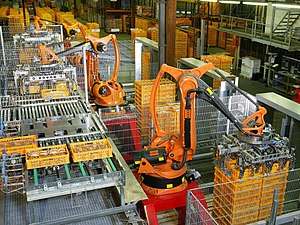
A major change in the United Kingdom was the development in 1961 of the Chorleywood bread process. This used the intense mechanical working of dough, and control of gases touching dough, to dramatically reduce the fermentation period and the time taken to produce a loaf at the expense of taste and nutrition.[27]
For generations, white bread was the preferred bread of the rich while the poor ate dark (whole-grain) bread. However, in most western societies, the connotations reversed in the late 20th century, with whole-grain bread becoming preferred as having superior nutritional value while Chorleywood bread became associated with lower-class ignorance of nutrition.[28]
More recently, and especially in smaller retail bakeries, chemical additives are used that both speed up mixing time and reduce necessary fermentation time, so that a batch of bread may be mixed, made up, risen, and baked in fewer than three hours. Dough that does not require fermentation because of chemical additives is called "quick bread" by commercial bakers. Common additives include reducing agents such as L-cysteine or sodium metabisulfite, and oxidants such as potassium bromate or ascorbic acid;[29][30] this last ingredient is added to wholemeal bread to increase the softness of the loaf.[31] Calcium was added to flour in the UK to prevent rickets which had been detected as common in women who joined the World War 2 effort.[31]
Since 1986, domestic breadmakers that automate the process of making bread have become popular in the home.[32]
Notes
- Briggs, Helen (17 July 2018). "Prehistoric bake-off: Recipe for oldest bread revealed". BBC News. British Broadcasting Corporation. Retrieved 17 July 2018.
- Arranz-Otaegui, Amaia; Gonzalez Carretero, Lara; Ramsey, Monica N.; Fuller, Dorian Q.; Richter, Tobias (16 July 2018). "Archaeobotanical evidence reveals the origins of bread 14,400 years ago in northeastern Jordan". Proceedings of the National Academy of Sciences. 115 (31): 7925–7930. doi:10.1073/pnas.1801071115. PMC 6077754. PMID 30012614.
- Behrendt, Larissa (22 September 2016). "Indigenous Australians know we're the oldest living culture – it's in our Dreamtime | Larissa Behrendt". The Guardian. ISSN 0261-3077. Retrieved 13 August 2019.
- "Prehistoric man ate flatbread 30,000 years ago: study". phys.org. Retrieved 13 August 2019.
- "Feldman, Moshe and Kislev, Mordechai E., Israel Journal of Plant Sciences, Volume 55, Number 3–4 / 2007, pp. 207–21, Domestication of emmer wheat and evolution of free-threshing tetraploid wheat in "A Century of Wheat Research-From Wild Emmer Discovery to Genome Analysis", Published Online: 3 November 2008". Archived from the original on 6 December 2013. Retrieved 6 July 2011.
- Colledge, Sue; University College, London. Institute of Archaeology (2007). The origins and spread of domestic plants in southwest Asia and Europe. Left Coast Press. pp. 40–. ISBN 978-1-59874-988-5. Retrieved 5 July 2011.
- Popova, T. (2016) Bread remains in archaeological contexts. Southeast Europe and Anatolia in Prehistory Essays in Honor of Vassil Nikolov on His 65th Anniversary, eds Bacvarov, K.; Gleser, R. (Habelt, Bonn), pp 519–526.
- González Carretero, L.; Wollstonecroft, M.; Fuller, DQ. (2017) A methodological approach to the study of archaeological cereal meals: A case study at Çatalhöyük East (Turkey). Veg Hist Archaeobot 26:415–432.
- Samuel, Delwen (1989). "Chapter 12: Their staff of life: Initial investigations on ancient Egyptian bread baking" (PDF). In Kemp, B. J. (ed.). Amarna Reports. 5. London: Egypt Exploration Society. pp. 1253–1290. ISBN 978-0-85698-109-8.
- Gonzalez Carretero, Lara (9 February 2017). "3,500-year-old bread and beer from the New Kingdom, Egypt". Retrieved 17 April 2017.
- Samuel, D. (1994). "An archaeological study of baking and bread in New Kingdom Egypt (doctoral thesis)".
- Samuel, Delwen (2000). "Chapter 22: Brewing and baking" (PDF). In Nicholson, P. T.; Shaw, I. (eds.). Ancient Egyptian materials and technology. Cambridge: Cambridge University Press. pp. 537–576. ISBN 9780521452571.
- Samuel, D. (1996). "Investigation of Ancient Egyptian Baking and Brewing Methods by Correlative Microscopy". Science. 273 (5274): 488–490. doi:10.1126/science.273.5274.488. PMID 8662535.
- Samuel, Delwen (2002). "Bread in archaeology". Civilisations (49): 27–36. doi:10.4000/civilisations.1353.
- Tannahill, Reay (1973). Food in History (Stein and Day. ISBN 0-8128-1437-1). p. 68f.
- Toussaint-Samat 2009, p.202
- Toussaint-Samat 2009, p.204 gives a date of 168 for "a considerable influx of craftsmen bakers (pistores) of Greek origin into Rome".
- Chrysippus of Tyana gives a list of thirty kinds, without commentary (Toussaint-Samat 2009, p. 202).
- Tannahill p. 91
- Changes in diet are reflected in the modern significance of opson as fish (Toussaint-Samat 2009, p. 202); in Italy the contorni are now the accompaniment to meat rather than bread.
- Tannahill p. 227
- Coley, Noel (1 March 2005). "The fight against food adulteration". Education in Chemistry. Vol. 42 no. 2. Royal Society of Chemistry. pp. 46–49. Archived from the original on 14 June 2018. Retrieved 14 June 2018.
- MS., City Clerk's Office, Record Book, 1814-1820, pp. 3, 5.
- The Trade Marks Journal.
- "Sliced Bread Turns 80 Years Old". Chillicothe Constitution-Tribune. 7 July 2008. Retrieved 6 July 2011.
- It occupies a section in Sigfried Giedion, [1948] 1969. Mechanization Takes Command (Oxford University Press).
- "Criticisms of the Chorleywood bread process". Archived from the original on 22 May 2012.
- Christianne L.H. Hupkens, Ronald A. Knibbe and Maris J. Drop, for example analyzed social class variation in the intake of fat and fibre, including white bread consumption, in Maastricht, Liège and Aachen, "Social Class Differences in Women's Fat and Fibre Consumption: A Cross-National Study" 1995; the literature on class perceptions and diet is enormous.
- Pyler, Ernst John (1958). Our Daily Bread. Siebel. p. 703.
- Elkassabany, M.; Hoseney, R.C.; Seib, P.A. (1980). "Ascorbic Acid as an Oxidant in Wheat Flour Dough. I. Conversion to Dehydroascorbic Acid" (PDF). Cereal Chem. 57 (2): 85–87.
- "Modern History of Bread - 20th Century UK". Federation of Bakers.
- Nonaka, I.; Takeuchi, H. (1995), The Knowledge-Creating Company, Oxford University Press.
